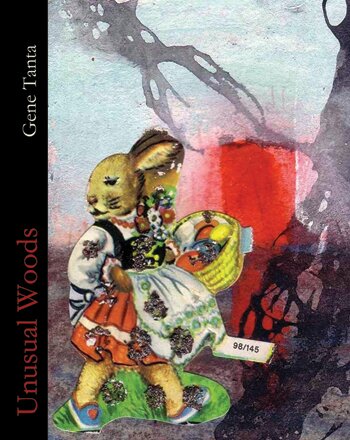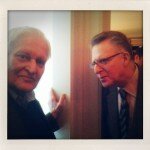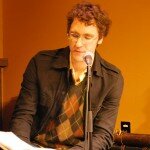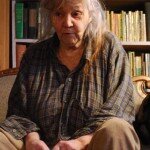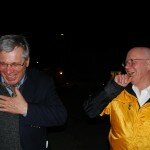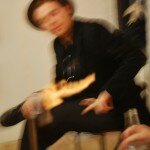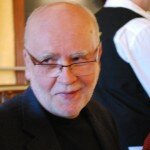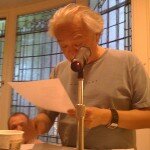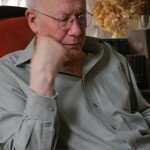What are some reasons why we read poetry? Why turn to a poem over a novel, a play, a philosophical treatise? In this essay I want to suggest that we turn to poetry out of a fundamental desire to answer the question, How should one live? By making this claim, I am attempting to wonder about poetry’s relationship to the ethical, broadly conceived here as partaking in the four distinctions of ethical criticism as laid out by Wayne Booth in his book The Company We Keep: An Ethics of Fiction and then paraphrased and articulated by Martha Nussbaum in Love’s Knowledge: Essays on Philosophy and Literature. Those distinctions are 1.) Asking of a literary work, as Nussbaum writes, “What relationship does my engagement with it have to my general aim to live well?” 2.) “What sense of life is expressed in this work as a whole?” 3.) As there are “many good things for literature to do and be,” how do we talk about ethical criticism without reducing it to some “single dogmatic theory”? 4.) “What becomes of readers as they read?” (Nussbaum 232-233)
Furthermore, while I am interested in asking these questions more broadly about poetry, my emphasis in this essay will be on the work of John Ashbery, whose work I have found sustaining, consoling, and always interesting for about a decade now. Because the question, “How should one live,” is so resolutely personal, it seems important to choose a poet with whom I also feel – without knowing him personally at all – a kind of personal connection. For if literary works are, as Wayne Booth writes, like friends, and “we can assess our literary relationships in much the same way that we assess our friendships, realizing that we are judged by the company we keep,” then it seemed of the utmost importance to write about a “friend” that has, to paraphrase Nussbaum, enriched my life, however distantly, in a substantial way. (Nussbaum 234) Indeed, one of our greatest readers, Harold Bloom, has written,
Reading well is one of the great pleasures that solitude can afford you, because it is, at least in my experience, the most healing of pleasures. It returns you to otherness, whether in yourself or in friends, or in those who may become friends. Imaginative literature is otherness, and as such alleviates loneliness. We read not only because we cannot know enough people, but because friendship is so vulnerable, so likely to diminish or disappear, overcome by space, time, imperfect sympathies, and all the sorrows of familial and passional life. (19)
So if Ashbery has been a kind of “good friend” to me over the years, how has his work enriched my life?
2.
Let me start here: I remember vividly the first time I came across Self Portrait in a Convex Mirror, at Shamandrum Bookstore in Ann Arbor in 2003. The orange spine of the book caught my attention, and I pulled the slim volume off the bookshelf and read Bloom’s exultant blurb, in which he placed Ashbery in the company of poets like T.S. Eliot and Hart Crane. I opened the book to the first poem, and read
I tried each thing, only some were immortal and free.
Elsewhere we are as sitting in a place where sunlight
Filters down, a little at a time,
Waiting for someone to come. Harsh words are spoken,
As the sun yellows the green of the maple tree….
So this was all, but obscurely
I felt the stirrings of new breath in the pages
Which all winter long had smelled like an old catalogue.
New sentences were starting up. But the summer
Was well along, not yet past the mid-point
But full and dark with the promise of that fullness,
That time when one can no longer wander away
And even the least attentive fall silent
To watch the thing that is prepared to happen. (427)
Reading that passage from Ashbery’s “As One Put Drunk Into a Packet-Boat,” I myself “felt the stirrings of new breath in the pages”. There was something mysterious and lyrical about the passage, something exquisite, moving, and funny. Who else wrote in their poems about the “smell of an old catalogue”? What was the “thing” that was prepared to happen? The poem captured the excitement one might feel during the time the symphony warms up, that scintillating sound of instruments testing their timbers, meeting each other in the strange arena of sound, coming together to produce “the promise of that fullness,” for which “the least attentive fall silent / To watch the thing that is prepared to happen.”
I bought the book. I had never come across a poet as suggestive as Ashbery, nor read anyone with such a mastery of language. As a child I had loved The Phantom Tollbooth, and perhaps a part of me was still searching for that one conductor who, as he swung his baton in the air, could orchestrate the movement and color of the sun setting and rising. Ashbery, more than any poet I had read up that point, struck me as that conductor. His poems were participatory events, musical and visual as well as verbal, as rich with fecund possibility as W.H. Auden’s early poems, which I had fallen in love with a few months earlier. And as I read more Ashbery, certain questions began to percolate. The main question was: How could criticism talk about as rich a poet as Ashbery, without somehow suffocating his suggestiveness, his wacky humor, his idiosyncratic and imaginative gifts? Why was I so taken with the poetry?
3.
Richard Rorty has written of Harold Bloom that,
His ideal reader hopes that the next book she reads will recontextualize all the books she has previously read – that she will encounter an authorial imagination so strong as to sweep her off her feet, transport her into a world she has never known existed. In this new world, all the authors and characters with who she has previously been acquainted will look different…The reader’s real-life friends, relations and neighbors will also look different, as will their motives and choices. (390)
I love this quote, because this is exactly what happened when I read Ashbery. I was transported, swept off my feet. Everything I had read up to that point changed – it was if a great shifting occurred in my mind, not exactly suddenly but gradually – and over time I began to compare what I read – mostly 20th century American poetry – with the surprise, enchantment, and supple, tremendous sense of humor and nostalgia I found in Ashbery. And when I found much work lacking in the virtues I admired in Ashbery – taking itself too seriously, say, like in the work at times of W.S. Merwin or T.S. Eliot, or taking itself too un-seriously, like in the work of Allen Ginsberg and many of the Beat poets – I would continually return to Ashbery’s work, still startled, still unsure of how a mind could so continually surprise me with its jarring juxtapositions, its risks, its sheer imaginative chutzpah. As times passed, I became basically in awe of Ashbery’s poems, for I could not find in any poet’s work – with the exception of some major poets, like Stevens, Whitman, Elizabeth Bishop, A.R. Ammons – as ferocious a freshness, a newness, a kind of constantly renewing something that made the poems always delightfully baffling, pulling me into their dazzling fields, astonishing me with their metaphors, and making me gulp with pleasure at their sheer unwillingness to be pigeon-holed in any way.
4.
So, let us return to Nussbaum’s paraphrasing of Booth, What sense of life is expressed in Ashbery’s work as a whole? What relationship does my engagement with it have to my general aim to live well? For this we have to look at a poem. Hence, here is a shorter poem, “Spring Cries,” from Ashbery’s book from 1994, called And the Stars Were Shining:
Our worst fears are realized.
Then a string of successes, or failures, follows.
She pleads with us to say: “Stay,
just for a minute, can’t you?”
We are expelled into the dust of our decisions.
Knowing it would be this way hasn’t
made any of it easier to understand, or bear.
May is raving. Its recapitulations
exhaust the soil. Across the marsh,
some bird misses its mark, walks back, sheepish, cheeping.
The isthmus is gilded white. People are returning
to the bight: adult swimmers, all of them. (4)
How do we read this poem? Where do we draw the line between description and metaphor? For example, how does one read “The isthmus is gilded white” – is this literally a description of an isthmus, perhaps alluding to the way the sun hits it at a particular hour, or is there something about the isthmus being “gilded white” to suggest bafflement, bewilderment, or even a kind of tentative beauty? But let me first back up. Notice the way the poem begins, by refusing to make a statement that cannot itself be contradicted. “Our worst fears are realized” we read, and we think “oh no! This is likely to be a sad or mournful poem” – at which point we read, “Then a string of successes, or failures, follows.” Suddenly we are completely in the Ashberian universe, where “either/or” is constantly exploded to make way for “both.” And the first two lines are general enough to relate to anyone reading – who hasn’t experienced failure and success in ways that are always unpredictable? And who hasn’t heard the desperation and sadness of someone asking, “Stay, just for a minute, can’t you?”
The poem therefore evidences an exhaustion, a sort of uncaring about what happens next – success or failure, who cares? They both simply ebb and flow, lapping up onto the sand of our lives in ways we can never hope to predict or anticipate. Better to simply stand apart without attaching too much sense or meaning to these changes (?). But if this is the speaker’s stance, what is ours? Do we agree with the speaker? Do we empathize with him or her? Of course, at certain times in our lives we would agree; at other times we might not. Either way, Ashbery says, “We are expelled into the dust of our decisions,” though this knowledge is not easy to “understand, or bear.” For the world, like the month of May, is “raving” – crazy, loony, enigmatic, never to be fully understood. And all the iterations of May, unlike what we normally associate with spring, do not cause a regeneration of the soil but instead “exhaust” it.
As we continue to read the poem, it becomes clear to us that the poem is just general enough for us to relate to it, but just particular enough for us to be aware of a different speaker speaking, and of the multitude of possibilities that might have been spoken instead. For couldn’t this just as likely have been a poem of celebration of May? Instead, however, the poem is about a kind of sad human incompetence, finitude. For even the bird on the marsh, we learn, feels “sheepish” and “misses the mark.” And then the very enigmatic ending, which I read as suggesting a kind of futility related to everything that is happening around the speaker – still, despite all of our successes and failures, and our inability to know which will come next, still we jump into the water, we jump into the next bend in our fate, somehow willingly, even as adults! What a weird and revolting and exhausting (and amazing?) state of affairs!
I want to emphasize again here that the sense of life as expressed in this poem is a contingent one, based upon the speaker’s circumstances and place at the time of the writing of the poem. Whether Ashbery is making up a speaker, or is articulating his own particular worldview at the moment, is unimportant. What is important is that we are being presented with a whole worldview, a whole philosophy, and we are then asked to wonder about it, to be made aware that, like the speaker, we are particular people in a particular time with our own preoccupations, and that here is an entirely different person with his or her own idiosyncratic and interesting preoccupations. Naturally, then, we might wonder, What are our own idiosyncratic and interesting preoccupations? If we were the speaker of the poem, would we lend more credence to agency? Would we agree with what we perceive to be the speaker’s exhaustion? Do we nod our heads knowingly or raise an eyebrow as if to say, Is this really how we feel about things?
5.
See how the poem, then, occasions such ethical reflections, merely by unfolding its own kind of logic of particulars. And this thickness of description, this polytheistic quest, seems to be the reason why Rorty and Martha Nussbaum praise the novel as a moral agent, (although they might as well be praising poetry as well), capable of nothing less than, in Nussbaum’s words,
psuchagogia (leading of the soul), in which methodological and formal choices on the part of the teacher or writer [are] bound to be very important for their eventual result: not just because of their instrumental role in communication, but also because of the values and judgments they themselves [express] and their role in the adequate stating of a view. (16-17)
“The values and judgments they themselves [express] and their role in the adequate stating of a view” – in our case, a view in “Spring Cries” that life is absurd, hard-to-grasp, frustrating and sometimes exhausting. But remember – this is the speaker speaking. And Ashbery’s poems are rife with polyvocality, with an almost perverse pleasure in a chorus of voices and images jostling against each other, all competing for our attention, all calling attention to what Nussbaum calls “the incommensurability of our values,” how we are incapable of prioritizing our real values but instead must learn to be as responsive as possible to the “ethical relevance of circumstances.” (37) And the plethora of vocabularies and idioms and tones that Ashbery employs means that one quickly learns to become sensitive to many things in his poems, including tone, mood, word choice, rhythm, allusion, “subject matter” and much more. For this reason, Ashbery’s poems are both about moral progress as increased sensitivity, or the ethical relevance of circumstances, while at the same time they enact this kind of moral progress in the reader, through his or her process of deep reading. By sensitizing the reader to a larger and more diverse set of possibilities, Ashbery’s poetry serves as a kind of poetic guidebook of what Wallace Stevens, another life-teacher, called “How to Live, What to Do.”
6.
“What becomes of readers as they read?” Nussbaum writes of an “ethical ability that I call “perception”:…By this I mean the ability to discern, acutely and responsively, the salient features of one’s particular situation.” (37) Earlier in the same chapter she poses these questions:
Then, too, what overall shape and organization does the text seem to have, and what type and degree of control does the author present himself as having over the material? Does he, for example, announce at the outset what he is going to establish and then proceed to do just that? Or does he occupy, instead, a more tentative and uncontrolling relation to the matter at hand, one that holds open the possibility of surprise, bewilderment, and change? Do we know at the outset what the format and overall shape of the text is going to be? And how does it construct itself as it goes, using what methods? (33)
Hopefully it is clear at this point that Ashbery occupies “a more tentative and uncontrolling relation to the matter at hand, one that holds open the possibility of surprise, bewilderment, and change.” But what methods, as Nussbaum insightfully asks, does the poem use to construct itself? To attempt to answer these questions requires looking at one more poem. Here is the first stanza of “Valentine,” from Houseboat Days.
Like a serpent among roses, like an asp
Among withered thornapples I coil to
And at you. The name of the castle is you,
El Rey. It is an all-night truck stop
Offering the best coffee and hamburgers in Utah.
It is most beautiful and nocturnal by daylight.
Seven layers: moss-agate, coral, aventurine,
Carnelian, Swiss lapis, obsidian – maybe others.
You know now that it has the form of a string
Quartet. The different parts are always meddling with each other,
Pestering each other, getting in each other’s way
So as to withdraw skillfully at the end, leaving – what?
A new kind of emptiness, maybe bathed in freshness,
Maybe not. Maybe just a new kind of emptiness.
What is this poem talking about? How do we account for a poem that covers, in fourteen lines, serpents, castles, truck stops, Swiss lapis, a string quartet, and “a new kind of emptiness”?
Perhaps we can get at the meaning of this poem by investigating Ashbery’s usage of “you,” and placing this in the context of moral progress as increased sensitivity. For what is “you” in this poem? You are the name of a castle, an all-night truck stop, something beautiful and nocturnal, with the form of a string quartet. With each iteration of “you,” the poem expands our self-image, calling our attention to aspects of our experience and world that are not typically represented as thematic matter in a poem (say, an all night truck stop in Utah juxtaposed with the name of a castle). (In this sense, we might say that Ashbery’s quest is analogous to Whitman’s, in that both provide us with catalogues and categories that extend the boundaries of what we consider to be important, what we value.) It’s as if each iteration, each part of the catalogue, widens the circle of our self-image. In doing so, in pushing back the thresholds for what we consider parts of our community, our deep ethnocentrism, they redescribe us, and in doing so, redescribe our values. The poem is a microcosm of society, in which
The different parts are always meddling with each other,
Pestering each other, getting in each other’s way
So as to withdraw skillfully at the end, leaving – what?
A new kind of emptiness, maybe bathed in freshness,
Maybe not. Maybe just a new kind of emptiness.
What do all our interactions amount to? Simply and complexly the moment of our attention, the “mooring of our starting out,” an increased sensitivity to our particular circumstances. It is perhaps a “fresh emptiness,” meaning an invigorating life unclouded somewhat by the insidious quality of our devotions to overly abstract concepts like “Reason” or “Reality,” or it is just an emptiness, a kind of existential echo chamber or vacuum in which we make transitory meanings that importantly create hope for a better future and greater understanding, but which still take place in a world shorn of metaphysics, or absolutes, or, as Rorty puts it, “neutral starting points for thought.”
7.
Perhaps it is because there are no “neutral starting points for thought” that Ashbery begins his poems so often en media res. For it is a strategy that immediately evokes in the reader a bewilderment, a sense of not knowing where exactly he or she is, and this carries over, then, into the reader’s own situation while reading: How did we end up where we are? The effect of beginning in the middle of things prompts us to move from the microcosm of the poem to the macrocosm of our lives: What strange confluence of fate and chance has been orchestrated to work to produce the rather miraculous equilibrium in which we sit and read? What kind of balance does our present place in the universe suggest, and how in the world did we wind up where we are? These questions are raised instantaneously as we begin many Ashbery poems; which is to say, that many of Ashbery’s poems serve promptly to historicize us, while at the same time force us to directly participate in the poem, for if we don’t know where we are in the poem, the best we can do is focus and see if we can get our bearings within the poem. How is reality any different? Ashbery’s poems, in their self-consciousness, in their method of decentered unfolding, recreate for us a scene of living, in which we are compelled to participate and imagine in order to reach any tentative understandings about the poem, as about life.
This is what becomes of us as we read – we become more responsive and more perceptive as readers. “The resulting liberation,” Rorty writes,
may, of course, lead one to try to change the political or economic or religious or philosophical status quo. Such an attempt may begin a lifetime of effort to break through the received ideas that serve to justify present-day institutions. But it also may result merely in one’s becoming a more sensitive, knowledgeable, wiser person…the change is not a matter of everything falling nicely into place, fitting together beautifully. It is instead a matter of finding oneself transported, moved to a place from which a different prospect is available. (390 – 391)
Sources
Ashbery, John. Collected Poems, 1956 – 1987. New York: Library of America, 2008. Print.
Ashbery, John. And the Stars Were Shining. New York: Farrar, Straus and Giroux, 1994. Print.
Bloom, Harold. How to Read and Why. New York: Simon and Schuster, 2000. Print.
Nussbaum, Martha. Love’s Knowledge: Essays on Philosophy and Literature. New York: Oxford University Press, 1990. Print.
Voparil, Christopher J., and Richard Bernstein eds. The Rorty Reader. Oxford: Wiley-Blackwell, 2010. Print.
 Katharine Sell is a 3rd year student majoring in Biology focused in coral reef ecology and marine organisms. She enjoys writing in her spare time. She loved exploring ‘meaning’ in “The Idea of Order at Key West” in correlation to her passions for people and all that the sea possesses.
Katharine Sell is a 3rd year student majoring in Biology focused in coral reef ecology and marine organisms. She enjoys writing in her spare time. She loved exploring ‘meaning’ in “The Idea of Order at Key West” in correlation to her passions for people and all that the sea possesses.
